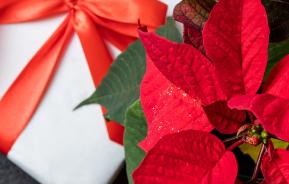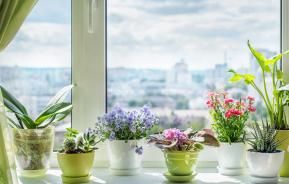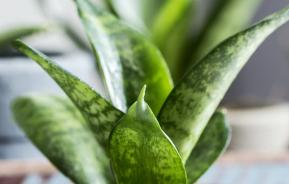Poinsettias are one of our most popular Christmas houseplants – and frequently given as Christmas gifts. There’s no doubt that they provide a bright, cheery festive feel to any home and a colourful centrepiece.
They are the most colourful of any Euphorbia we grow and, as its species name pulcherrima suggests: ‘the most beautiful’.
Poinsettias are grown for their large leafy bracts, which surround the real flowers, the small insignificant yellow ‘blobs’ at the centre.
Although red is still the most common and traditional colour, white, pink and bicoloured/marbled varieties are also available.
We have more information on poinsettias and other Christmas houseplants. December 12 each year is International Poinsettia Day.
The milky sap that comes from cut poinsettia stems may cause skin irritation, in the form of a rash, if you have sensitive skin and come into contact with the sap.
How to grow poinsettias
Poinsettias need a position in bright, but filtered light, away from strong sunlight. They need a minimum temperature of 13-15°C (55-60°F), but away from sources of direct heat – such as an open fire or radiator – and away from draughts.
Poinsettia varieties
There are numerous named varieties of poinsettias, although most suppliers rarely provide the name – you simply buy them on the colour of their bracts. But here are some of the best ones.
- Chianti: Rich, wine-coloured bracts.
- Cortez Series: Cortez Burgundy, deep plum; Cortez Electric Fire, red; Cortez White; Cortez Candy, pink.
- Lemon Snow: Pale yellow bracts.
- Marblestar: Pink bracts with white margins.Red Velvet Dusky pink bracts.
- Silver Star: Dusky pink bracts and variegated leaves.Sonora White Glitter Red bracts with white splashes.

Planting poinsettias
Poinsettias aren’t too fussy about their compost, but use a good multi-purpose such as John Innes No 3 Compost (3 parts to 1 part grit) or a multi-purpose with added John Innes.
Only repot plants to the next size pot in spring.
Suggested planting locations and garden types
Houseplant, indoor plant, summer patio plant.
How to care for poinsettias
Care for poinsettias starts when you buy them. Because they are sensitive to cold and winds, which can damage the foliage and cause it to drop prematurely, never buy one from an outdoor market or garage forecourt.
Always ask the shop to wrap the plant in a houseplant wrapper, including over the top of the foliage, to protect it.
Wherever possible, try to buy British. British-grown poinsettias are grown ‘hard’, which makes them tougher than those grown in many European countries, which are more susceptible to adverse conditions. Ask in the shop if theirs are British poinsettias.
Water poinsettias sparingly, aiming to keep the compost moist – allow the top of the compost to slightly dry out before watering again – as overwatering will damage them. Always use tepid water – never cold water direct from the tap.
Feed fortnightly with a high potash plant food – or use one of the feed drippers available from garden centres.
Mist plants regularly to increase humidity around the plants or, better still, stand pots on trays of moist hydroleca or Hortag to help increase humidity.
Getting plants to colour up again
Many people dispose of their poinsettia plants after the festive season and when the bracts start to drop or lose their colour. But it is possible to get the bracts to colour up again for the following year – although it can be a bit of a tricky process. Cut back the stems to 10-15cm (4-6in) in April.
Repot the plants into a slightly bigger pot and grow them on in a light, cool place at a temperature of 15-18°C (60-65°F). They can even be put outdoors in summer, on a sheltered patio, once temperatures reach at least 15°C (60°F).
Bract colouring is brought on by short winter day length. From October/November onwards, plants need 12 hours of complete darkness every day, for a period of 8 to 10 weeks. So place the plants in a dark cupboard or cover them with a cardboard box or light-proof bag. Even one night of missing this dark treatment or accidentally exposing them to light, can stop/hinder the colouring process. Plants need a constant temperature of about 18°C (55°F) to colour up well.
| Flowering season(s) | Winter |
|---|---|
| Foliage season(s) | Spring, Summer, Autumn, Winter |
| Sunlight | Partial shade |
| Soil type | Loamy |
| Soil pH | Neutral |
| Soil moisture | Moist but well-drained |
| Ultimate height | Up to 60cm (2ft) |
| Ultimate spread | Up to 45cm (18in) |
| Time to ultimate height | 1-2 years |








